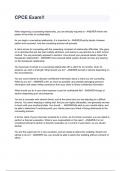Summary
Samenvatting Disorders of Childhood - Developmental Psychopathology
- Course
- Institution
- Book
Disorders of Childhood 4th Edition (Parritz & Troy), a complete summary with tables and pictures of models. All the key terms and concepts are green.
[Show more]













